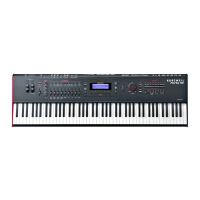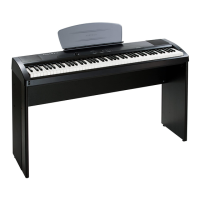Keymap and Sample Editing
The Keymap Editor
9-3
Parameter Range of Values
Sample Sample Root list
Key Range Variable from C0-G10
Low Key C 0 to G 10
High Key C 0 to G 10
Velocity Range (VelRange) Variable from ppp-fff
Low Velocity (Lo) ppp-fff
High Velocity (Hi) ppp-fff
Coarse Tune –128 to 127 semitones
Fine Tune -49 to 50 cents
Master Transpose -126 ST to127 semitones
Volume Adjust ± 24 dB
Keymap Editor Parameters
Sample
is is where you assign a sample root to the current key range. Depending on the nature of
the sample root—an individual sample or a block of sample roots—the sample’s name looks
a bit dierent in the display. Each sample’s name consists of three parts: a numeral, a name,
and a note number—for example, 999 Silence-C4. Additionally, the name of stereo samples
will end with an S. (To use a stereo sample, the Stereo parameter must be set to On in the
Program Editor, and two keymaps must be selected.)
e numeral is the sample block ID. If the sample object is an individual sample, the sample
block ID is the same as the sample’s object ID. If the sample object is a group of sample
roots, the object ID of the rst root in the group determines the sample block ID. e
remaining roots in the block have the same ID, and dier only in their note numbers.
Next comes the name of the sample, which typically describes the sample’s timbre. e nal
part of the sample’s name refers to the pitch at which it was originally sampled. For many
timbres, multiple samples are made at various pitches. As you scroll through the Sample
list, you’ll see only the pitch of the sample change until you reach the next sample block.
e sample’s original pitch is set in the Sample Editor (see Root Key on page 9-12). is
determines which key will play the sample at its original pitch when a sample is used in a key
range (see Key Range below).

